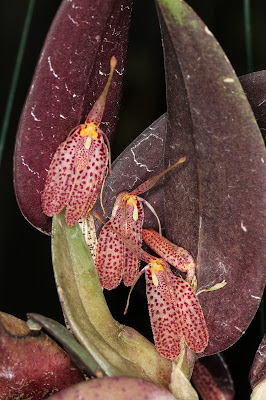Restrepia echo was discovered by Carl Luer in northwestern Colombia. It grows as an epiphytic at an altitude of 1500-2000 meters above sea level.
Restrepia echo also called as Echo's Acronia, is a species of the Restrepia genus. This species was described by Carlyle August Luer & Rodrigo Escobar in 1996.
IDENTIFY RESTREPIA ECHO
Restrepia echo was discovered by Carl Luer in northwestern Colombia. It
grows as an epiphytic at an altitude of 1500-2000 meters above sea level. Luer
has photographed the plant together with Rodrigo Escobar.
It is a mini-miniature sized, cool growing epiphyte with erect ramicauls enveloped by 6 to 9 thin, whitish, loose, compressed, densely spotted, more or less imbricating sheaths and carrying a single, apical, erect, thickly coriaceous, purple suffused beneath, ovate, acute, broadly cuneate to rounded below and contracted into the petiolate base leaf. The leaves are 4-6 cm long and 0.7-1.2 cm wide.
Echo's Acronia blooms in the spring on a fascicle of slender, successively single flowered inflorescence arising from low on the back of the leaf and has a thin, tubular floral bract. The flowers are 2.5 cm measured from top to bottom, 0.2 to 1.3 cm wide.
RESTREPIA ECHO CARE AND CULTURE
Cultural information should only be used as a guide, and should be to be adapted to suit you. Your physical location; where you grow your plants, how much time you have to devote to their care, and many other factors, will need to be taken into account. Only then can you decide on the cultural methods that best suit you and your plants.
Light:
Restrepia echo needs a light level of 18000-25000 lux. The light should be somewhat filtered or diffused and the plants should not be exposed to direct sunlight during midday hours. This species grow well under artificial light.
Temperature:
Although they prefer the cold greenhouse, Echo's Acronia are very tolerant of growing conditions. If the compost remains wet, they can withstand temperatures above 35 °C. There is simply a slowdown in growth and flowering when the temperatures are too high. Ideal temperatures are between 10 and 18 ° C at night and 18 to 26 ° C during the day.
Humidity:
Restrepia echo needs a humidity level of greater than 60% for potted plants, close to 80% for mounted plants. Too dry air has a negative effect on the development of the plant: its growth is inhibited, and the leaves begin to turn yellow and dry out. The higher temperature, the higher the humidity should be, and the higher the humidity, the more often and longer it is necessary to ventilate the room where the plants are contained, otherwise the probability of rotting and various kinds of fungal diseases.
Substrate and growing media:
Restrepia echo can be grown in pots with a good draining substrate of pine bark and chopped sphagnum moss, to which we can add perlite, charcoal, polyurethane foam or polystyrene fragments in small quantities. The plants can also be grown in pure sphagnum moss, rock wool, mounted on cork, tree fern. When mounted, care should be taken to maintain good humidity.
Repot every 2 years, in late winter or early spring. These plants do not tolerate decomposed substrate and should be repotted as soon as the substrate begins to decompose or as they outgrow their pots. If we transplant when new roots begin to emerge, the plant will take root in the shortest possible time.
Under good growing conditions, the clumps of Restrepia double in size every year. We can then divide them by cutting the tuft. Many species also produce seedlings or keikis, that it is possible, when sufficiently developed, to separate from the mother plant. It is also possible to make leaf cuttings . It is then necessary to take a leaf that has already flowered, with part of its branch, and half-bury it in compost kept constantly moist (cover the pot with plastic food wrap). A few months later, small leaves appear. The result is a plant capable of flowering in 1 to 2 years.
Watering:
Echo's Acronia love humidity, their roots never have to dry out completely. In nature they have a continuous vegetative cycle, so we wet them regularly all year round to keep the substrate moist but we must avoid stagnation of water because they cause rot at the roots.
Watering is directly dependent on the temperature of the content, the higher it is, the more often it needs to be watered. Plants growing on blocks or with a bare root system, preferably watered daily in the morning, so that in the evening their roots can dry out relatively well. During the summer heat, additional spraying is possible. When watering, excess water should flow freely from the pot, since stagnation of water both inside the pot and in its pan can very quickly lead to rotting of the roots and the lower part of the plant.
Fertilizer:
During the period of active growth, plants should be fertilized every week 1/4-1/2 of the recommended dose of fertilizer for orchids. Many growers prefer to use a balanced fertilizer all year round, but there are those who use a fertilizer with increased nitrogen content from spring to mid-summer and then, in late summer and fall, start using fertilizer with a higher phosphorus content.
Rest period:
The cultivation conditions should be maintained throughout the year. In winter, the amount of water can be reduced somewhat, especially if the plants are grown under the dark, short-day conditions that occur in temperate latitudes. However, they must never be allowed to dry completely. If plant watering is limited, fertilization should also be reduced.
















the looks more to insect than a flower :)
ReplyDelete^^!
Delete